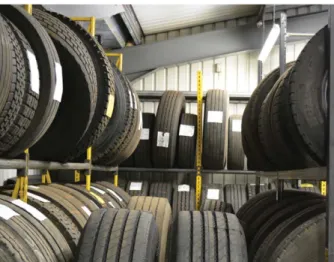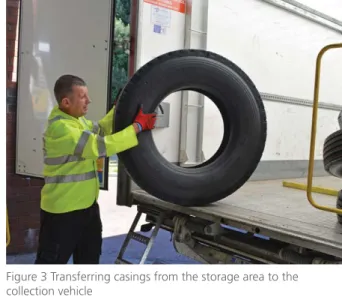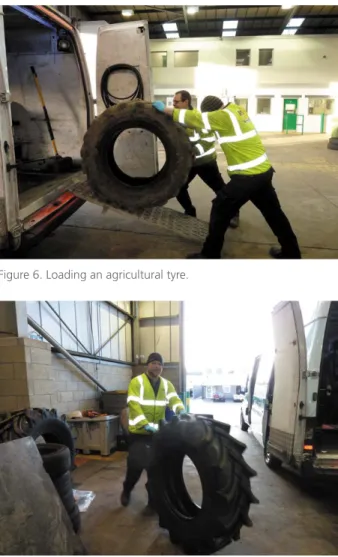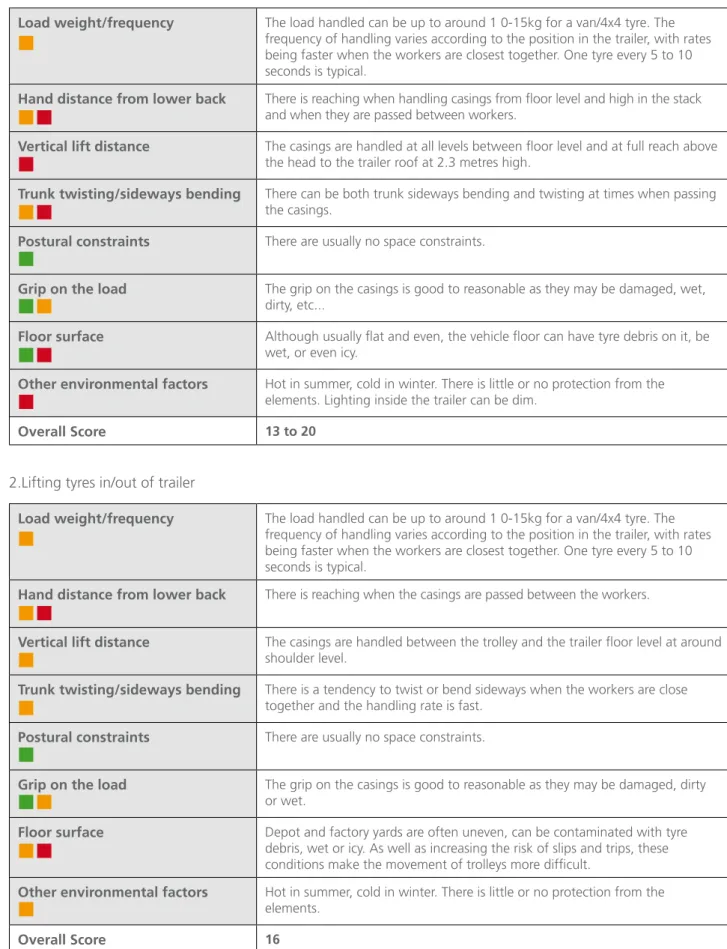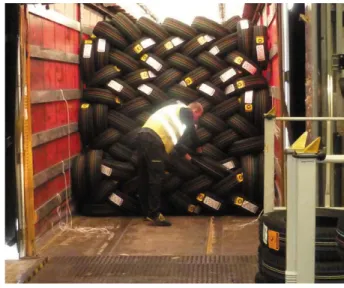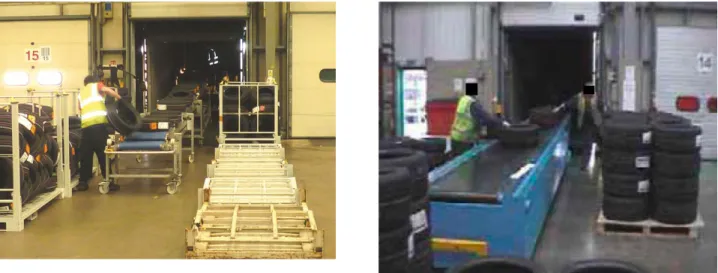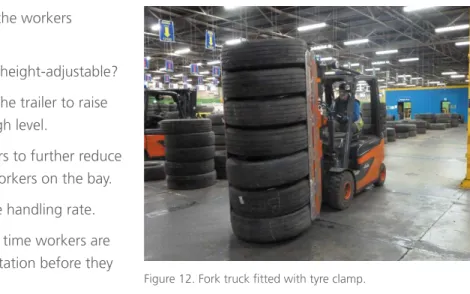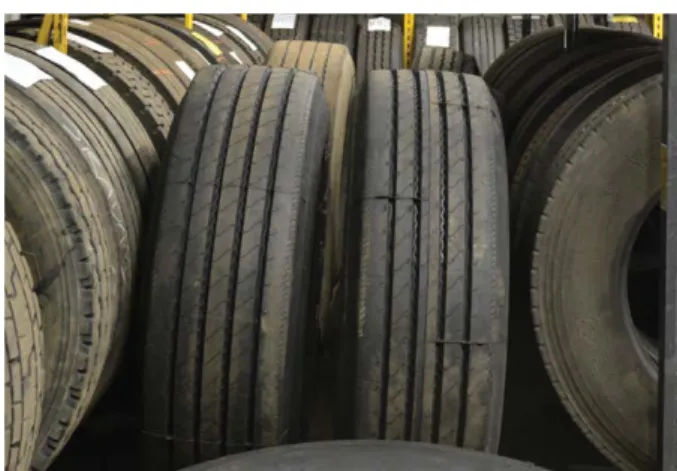A guide for employers tackling the risk of manual handling injuries
SCOPE
This guide is aimed at employers whose businesses involve collecting and delivering new or used vehicle tyres and at employers who receive or despatch tyres to and from their premises. The guidance is relevant to employers who manufacture, store, distribute, collect, deliver and retail vehicle tyres and to tyre retread businesses, road haulage businesses and bus operating companies.
It is limited to dealing with the risk of musculoskeletal disorders arising from manual handling of vehicle tyres during collection and delivery. It does not cover tyre handling during manufacturing or retreading of tyres. Nor does it apply to manual handling when fitting tyres to, or removing them from, vehicle wheels. However, the risks involved in these other activities will contribute to the total risk of injury from manual handling of tyres and employers must take these into account when assessing the overall risk.
ACKNOWLEDGEMENTS
This guide has been prepared by the Tyre and Rubber Industries Safety Action Group (TRISAG) in consultation with the Health and Safety Executive (HSE). TRISAG wishes to record its appreciation and thanks for the help given and information provided by the Health and Safety Executive. The document was first produced through the Rubber Industry Advisory Committee (RUBIAC) as “Collection and delivery of tyres: Tackling the risk of manual handling injuries - A practical guide for all employers involved in the collection, delivery, receipt and despatch of tyres”.
Ergonomists at the Health and Safety Laboratory provided the case studies, risk assessments and professional advice contained in the original guide and we are grateful for their permission to reproduce their original work in this document. We are also grateful to those who have contributed in any way to the preparation of this updated guide.
The HSE welcomes this new version of Collection and delivery of tyres that has been revised by TRISAG. The updated guidance will continue to help dutyholders control the manual handling risks during the collection and delivery of tyres.
INTRODUCTION
Vehicle tyres are heavy and can be awkward to handle. People involved in collecting and delivering tyres will be at risk of suffering musculoskeletal disorders (MSDs) and other injuries unless the risks are properly controlled. This guide shows a series of typical manual handling problems during collection and delivery of tyres, outlines the level of risk in each case and gives suggestions for how those risks can be reduced. You will need to apply the same approach to other manual handling activities involving tyres. The guide also contains some general principles to follow and gives advice on manual handling training for employees.
The guide presents recognised industry good practice in assessing manual handling risks and reducing the overall risks of people sustaining manual handling injuries from handling tyres. Following the guidance is not compulsory, unless specifically stated, and you are free to take other action. But if you do follow the guidance you will normally be doing enough to comply with the law and specifically your legal obligations under the Manual Handling Operations Regulations 1992 (as amended).
In each example the level of risk has been estimated and compared with the risk criteria published in Health and Safety Executive (HSE) guidance, in particular, INDG 383 Manual Handling Assessment Charts http://www. hse.gov.uk/pubns/indg383.pdf, MAC tool sheets and flow chart http://www.hse.gov.uk/msd/mac/pdf/ macpack.pdf and L23 Guidance on Manual Handling Operations Regulations 1992 (as amended) http://www. hse.gov.uk/pubns/books/l23.htm. In some cases certain characteristics of the task are beyond the scope of these guidance sources, in which case the expert judgement of the ergonomists has been used.
It is important to remember that when visiting drivers call to collect or deliver tyres at your site it is a shared workplace. In these circumstances you have a legal duty to cooperate with the driver’s employer as far as is necessary to allow the employer to meet their legal obligations for ensuring the driver’s health and safety. This includes the duty to minimise the risks of injury to the driver through manual handling. You also have a duty to coordinate the measures that you take to avoid and minimise the risks of injury through manual handling with those taken by the driver’s employer. So, when you plan measures to control manual handling risks, you need to take account of what visiting drivers have to do when they load or unload tyres to and from their vehicles. You will need to resolve any problems by discussion with the driver’s employer. Detailed guidance on employers’ duties to cooperate and coordinate their risk control measures can be found at:
http://www.hse.gov.uk/workplacetransport/information/cooperation.htm
HOW TO DEAL WITH MANUAL HANDING
Detailed guidance on the Regulations and how to deal with manual handling is covered in HSE publication L23 Guidance on Manual Handling Operations Regulations 1992 (as amended) http://www.hse.gov.uk/pubns/ books/l23.htm. The basic steps are as follows:
Step 1 – Avoid hazardous manual handling as far as possible
Look at all operations that involve lifting, carrying, transferring, pushing or pulling including those undertaken by visiting vehicle drivers who collect or deliver tyres from your premises. Ask yourself if the loads really need to be moved in that way. Can things be done differently? By reorganising the way you do things you may be able to eliminate hazardous manual handling operations. For example, can you use mechanical lifting aids and conveyor systems to avoid unnecessary handling?
Step 2 – Assess the risk of injury from manual handling that cannot be avoided and reduce the risk as far as possible
Observe each manual handling operation that takes place. Include those that are performed by visiting drivers. Consider how the operations could be made easier and less risky. Ask the workers and involve them in the process of thinking about improvements. Talk to the employers of visiting drivers as necessary. Make notes of your findings; then draw up and implement an action plan. Tackle those operations that cause the biggest risk first. Try out changes on a small scale initially, to make sure that they are workable.
Step 3 – Train your employees in safe handling techniques
Good training is very important but remember that, on its own, it cannot make up for an unsafe manual handling operation. The training should cover how to recognise harmful manual handling, appropriate systems of work, use of mechanical aids and good handling technique. More detailed advice is given at page 28.
CASE STUDIES
Explanation of Risk Factors
Wherever possible the assessments illustrated in the following case studies have been made using the MAC tool Manual Handling Assessment Charts (INDG 383). The colour coding is the same as that adopted by the MAC tool.
Purple Extremely high risk Red High risk
Amber Moderate risk Green Low risk
The numerical scores quoted are those derived by applying the MAC tool. The only significance of a numerical score is that will help the employer to decide priorities for action. For example, a task with an overall score of 20 should be given higher priority for risk reduction measures than a task for which the overall score is 10.
CASE STUDY 1
A delivery of car tyres at retail premises This task is performed daily. A delivery of new tyres can range from 6 to 30 or more tyres for a typical depot. The duration of the task is therefore short, even when a single member of staff does it. The tyres are unloaded from the delivery van and are usually stacked temporarily on the floor, or stood upright in rows, before being placed into racking like that shown in Figure 1. This can involve climbing a set of steps.
Risk factors
Load weight/frequency The load is up to a maximum of about 10kg for a 225/70 R15 van tyre. Typically the combination of load weight and frequency of handling will put the task within the low risk zone.
Hand distance from lower back There is some reaching away from the body when placing tyres into racking at both the high and low levels. Tyres are often handled with one hand.
Vertical lift distance The tyres are handled between floor level and above shoulder level.
Trunk twisting/sideways bending There is often some trunk twisting associated with this operation.
Postural constraints There is not usually a significant problem with space.
Grip on the load The grip on the tyres is good as they will be new, dry and clean.
Floor surface Since the task is performed inside, the floor surface is typically good. When a step ladder or ladder is used the risk is increased.
Other environmental factors Since this operation is usually performed inside, the lighting and thermal environment is usually good.
Overall Score 7
Assessment
The overall risk from this activity is low to moderate. The duration is short. The highest risk is in handling tyres into the racking where this is done above shoulder level or low to the floor.
Action
The vulnerability of special groups of employees should be considered where appropriate. The higher risk elements of the task should be examined closely and risk reduction measures considered.
Risk reduction measures to consider • Do the tyres have to be placed on the floor
before being racked? Can double handling be avoided by placing them onto something to keep them at a more suitable height such as a trolley? • It is important to have good stable steps for
accessing the racking. Those with handrails and a small platform at the top are best for this type of operation but they need to be practical and easily manoeuvred.
x Some sites have a mezzanine floor that is used as the storage area. A mobile conveyor like the one shown in Figure 2 can be a cheap and effective way of transporting tyres to and from the upper level.
Figure 2. A conveyor used to transport tyres to and from a mezzanine floor store.
CASE STUDY 2
Collection of used car tyre casings from retail premises This operation is performed regularly, for example,
once or twice weekly, and lasts for an hour or so, depending on the size of the retail premises and the rate at which they accumulate scrap casings. Collections of 150 to 400 tyres per week are normal.
Usually there is somewhere set aside where the casings are stacked each day as required. This may be a place where the casings can be laced into a stack against or between walls, and which is reasonably accessible for when the casings need to be transferred to the collection vehicle.
Figure 3 shows a good example of casings being rolled between the stack and the vehicle, however, the casings often have to carried through the tyre fitting bay or other operational parts of the premises, as shown in Figure 4. Distances of 10 metres are typical and tyres are rolled whenever possible rather than carried. The operation generally involves two retail staff and the collection driver. The driver works inside the vehicle, usually a rigid sided lorry, and laces the casings into it, (see Figure 5). One of the retail staff unlaces casings from their stack and rolls the casing to their colleague at the rear of the vehicle who lifts it in (to a height of approx 1250mm) and rolls it to the driver. Rolling the tyres avoids the strain of carrying them. The vehicle capacity is generally around 800 casings. The driver typically makes two collections the same day to pick up a full load.
Figure 3 Transferring casings from the storage area to the collection vehicle
Figure 4. Sometimes tyres are carried through the fitting bay, in
which case a carrying assessment should also be made. Figure 5. Lacing the casings inside the collection vehicle. A roof letting in daylight like this one makes the job easier.
Risk factors
1. Unlacing in the depot store
2. Lifting casings into the vehicle
Assessment
The assessment indicates a high risk for the lifting posture and lift distance factors. However, the overall risk presented by this operation is considered to be moderate due to its limited duration and weekly occurrence. The highest risk is in lacing casings inside the collection vehicle (and this is covered in later examples) because of the high frequency of handling and the range of postural factors associated with lacing at floor level and above head height.
Action
These tasks should be examined closely and risk reduction measures sought. Risk reduction measures to consider
• Consider mechanical handling methods for transferring the casings into the collection vehicle. For example, a non-powered roller conveyor could be used to avoid the need to roll or carry casings between the store and the vehicle. This would also reduce some of the bending involved. An extending conveyor, or one on castors, could be packed up and stored out of the way when not required.
• Provide a loading bay. This would eliminate the change in level, and a conveyor could be a useful alternative to the rolling operation.
• Ensure that the casing store is easily accessible for the collection vehicle, minimising the distance that the casings need to be carried or rolled (If there is carrying, a separate carrying risk assessment should be made). • Control stack or lacing height in the store area so that individuals do not handle casings above shoulder level. • Control stack height within the collection vehicle so that the driver does not handle casings above shoulder
level.
• Ensure that enough staff are available, and formally arrange for staff to swap around tasks before they find it fatiguing, e.g. every 30 minutes / 1 hour.
Load weight/frequency The load is up to a maximum of about 10kg for a 225/70 R15 van tyre. A 10kg load handled at 5 to 7 second intervals is just into the Amber zone, but mostly the task will be within the green zone.
Hand distance from lower back There is some reaching away from the body when lifting casings off the pile at a high and low level.
Vertical lift distance The casings are handled between floor level and above shoulder level.
Trunk twisting/sideways bending There is often some trunk twisting associated with this operation, especially if the vehicle is behind the worker when they are facing the stack.
Postural constraints There is usually not a significant problem with space.
Grip on the load The grip on the casings is good to reasonable as they may be damaged and dirty.
Floor surface Since the operation is usually performed under cover, the floor surface is typically good.
Other environmental factors Since this operation is usually performed under cover, the lighting, and thermal environment is usually reasonable, but it could be cold.
Overall Score 7 to 12
Load weight/frequency A 10kg load handled at 5 to 7 second intervals is just into the Amber zone. Mostly the task will be within the green zone.
Hand distance from lower back There is reaching when picking up casings from the floor, and into the vehicle.
Vertical lift distance As casings are rolled to the worker they will either be upright (and rolling) or laying flat on the floor. The lift is therefore always made from below knee level. The floor of the vehicle is at around 1250mm.
Trunk twisting/sideways bending There is usually some trunk twisting when transferring the casing between the floor and the vehicle.
Postural constraints There are none.
Grip on the load The grip on the casings is good to reasonable as they may be damaged, dirty or wet.
Floor surface This operation is usually performed outside the building, the floor conditions at retail premises are usually good, but can be wet or even icy.
Other environmental factors Cold in winter, hot in summer. Lighting may also be an issue.
Overall Score 8 to 14
CASE STUDY 3
Loading of wholesaler delivery vans - commercial and agricultural tyres At this site the wholesaler loads a fleet of small
vehicles with a wide variety of new tyres from warehouse stock, for delivery to retailers on a set of routes. The routes are repeated each day, but the tyres transported vary considerably from day to day. The company have specified their own fleet of vehicles for the purpose. In particular, the vehicles have a low internal floor level (less than 500mm above ground level) which aids the loading and unloading process. The range of tyres transported varies from 1kg for pneumatic trolley tyres to over 100kg for tractor tyres.
Loading into delivery vans is manual and usually performed by one member of the warehouse staff working with the vehicle driver. If necessary, and especially for larger agricultural tyres, another worker assists. Large tyres are rolled into the van by two or three workers pushing together up a ramp made of wooden planks, (see Figure 6). Provided this goes smoothly, the operation is relatively easy. The pushing force required to roll the tyre up the ramp depends upon the weight of the tyre, the angle of the slope and where the force is applied. For a slope of 30 degrees, the overall force is estimated to be between approximately one half and one quarter of the tyre weight.
Figure 6. Loading an agricultural tyre.
Figure 7. Some of the tyres can be very large.
Pushing risk factors
The MAC tool does not cover pushing and pulling tasks at present. A comparison with the risk assessment filter guidelines in L23 Guidance on Manual Handling Operations Regulations 1992 (as amended)
http://www.hse.gov.uk/pubns/books/l23.htm is more appropriate.
Assessment
For the largest tyres, (see Figure 7), the individual pushing forces associated with this operation can exceed the risk assessment filter figures in L23 Guidance on Manual Handling Operations Regulations 1992 (as amended) http:// www.hse.gov.uk/pubns/books/l23.htm. The risk associated with pushing these tyres is therefore high. Also, if one of the heavy tyres is allowed to fall over, apart from the risk of injury from being struck by the falling tyre, the risk involved when a team of two or three workers try to lift the tyre back to the upright position can be high.
The frequency of the operation is low and the duration is limited. If nothing goes wrong in the tyre rolling operation the overall risk is considered to be moderate to high.
Action
The higher risk elements of the operation should be examined closely and action taken to reduce the risks. Risk reduction measures to consider
• Keep the slope of the ramp as shallow as possible. The planks used in this case study were not suited to this operation. They were of different lengths, and therefore created different slopes, and they did not locate positively onto the floor of the vehicle. There was therefore a possibility that they could slip or move. Purpose made ramps would be an improvement. They should have as shallow an angle as is practical and a suitable non-slip surface. They should also be wide enough to allow the task to be performed as easily as possible.
• Use a small powered pedestrian operated lift truck to assist in getting these large tyres into the rear of the trucks. It would reduce the risk of a tyre toppling.
• Have a plan in advance for dealing with tyres if they do fall over.
Load The weight of tyres that are rolled ranges from about 25kg up to 170kg. These are not lifted or supported. If the tyre falls over, the load lifted to get it upright is up to half the tyre weight.
Frequency The loading operation is performed daily and only a limited number of the large tyres are loaded each day.
Pushing force The estimated overall pushing force required for large tyres up to 100kg will typically be between 25 and 50kgf on a 30 degree slope, and 17-34kgf on a 20 degree slope. For the largest tyres the overall pushing force may be as high as 85kg on a 30 degree slope.
Postures When rolling large tyres the posture is upright.
Grip on the load The tyres are clean and dry, the tread on agricultural tyres provides a reasonable grip for pushing.
Floor surface The warehouse floor is clean and even. However, the ramp may used, which can be steep or unstable.
Duration About 10 minutes per van. Warehouse based workers may be involved intermittently for around 2 hours daily.
Other environmental factors Loading work is done inside the warehouse. The doors can be closed to maintain warmth in winter. Housekeeping and lighting are good.
CASE STUDY 4
Loading & unloading in a retreading factory yard This operation applies to loads of similar tyre casings being brought in for retreading and to loads of retreaded tyres being sent out to customers by lorry. Some companies have no loading bay facilities and this creates particular handling difficulties.
Unloading
Casings are handled from a laced, or unlaced stack within the vehicle to a cradle trolley or gondola. They are usually laced into the cradle trolley. It is common for two workers to perform this operation, one in the vehicle pulling casings down and passing them to the second worker at ground level outside. Loading
During loading of tyres, the change in level between the floor surfaces outside and inside the vehicle creates an additional problem since the tyre has to be raised. The tyres are handled between the cradle trolley and the vehicle, where they will usually be laced. Larger tyres may simply be stacked unlaced.
In Figure 8 the workers are close together. When they are further apart there is the added problem of propelling the tyres/casings the distance between the stack and the tailgate of the trailer. The tyres or casings are usually bowled along the floor of the trailer.
Figure 8. Loading tyres in factory yard.
Risk factors
1.Loading/unloading in the trailer
2.Lifting tyres in/out of trailer
Load weight/frequency The load handled can be up to around 1 0-15kg for a van/4x4 tyre. The frequency of handling varies according to the position in the trailer, with rates being faster when the workers are closest together. One tyre every 5 to 10 seconds is typical.
Hand distance from lower back There is reaching when handling casings from floor level and high in the stack and when they are passed between workers.
Vertical lift distance The casings are handled at all levels between floor level and at full reach above the head to the trailer roof at 2.3 metres high.
Trunk twisting/sideways bending There can be both trunk sideways bending and twisting at times when passing the casings.
Postural constraints There are usually no space constraints.
Grip on the load The grip on the casings is good to reasonable as they may be damaged, wet, dirty, etc...
Floor surface Although usually flat and even, the vehicle floor can have tyre debris on it, be wet, or even icy.
Other environmental factors Hot in summer, cold in winter. There is little or no protection from the elements. Lighting inside the trailer can be dim.
Overall Score 13 to 20
Load weight/frequency The load handled can be up to around 1 0-15kg for a van/4x4 tyre. The frequency of handling varies according to the position in the trailer, with rates being faster when the workers are closest together. One tyre every 5 to 10 seconds is typical.
Hand distance from lower back There is reaching when the casings are passed between the workers.
Vertical lift distance The casings are handled between the trolley and the trailer floor level at around shoulder level.
Trunk twisting/sideways bending There is a tendency to twist or bend sideways when the workers are close together and the handling rate is fast.
Postural constraints There are usually no space constraints.
Grip on the load The grip on the casings is good to reasonable as they may be damaged, dirty or wet.
Floor surface Depot and factory yards are often uneven, can be contaminated with tyre debris, wet or icy. As well as increasing the risk of slips and trips, these conditions make the movement of trolleys more difficult.
Other environmental factors Hot in summer, cold in winter. There is little or no protection from the elements.
Assessment
For the worker in the trailer the MAC tool indicates a moderate risk associated with the weight of the tyre and the frequency of handling, and a high risk for the postural factors associated with stacking/unstacking between floor and ceiling height. In addition, for the most extreme postures adopted by the workers (in this case, handling the tyre below knee height and above shoulder level) when combined with the rate at which they work and the heaviest possible load (15kg), can result in the HSE risk assessment filter figures (in L23 Guidance on Manual Handling Operations Regulations 1992 (as amended) http://www.hse.gov.uk/pubns/books/l23.htm) being exceeded by up to 5 times. Note that exceeding the HSE risk assessment filter figure by a factor of about 2 indicates a serious risk of injury.
Action
For the task of handling the tyres between the trolley and the trailer, the operation should be examined closely and risk reduction measures sought. For the task of working in the trailer prompt action is needed to reduce the risks.
Risk reduction measures to consider
• If possible use an alternative to lacing -this could allow conventional handling aids to be used, such as powered lifting equipment.
• Avoid/reduce reaching and stooping – reduce the extent to which either of the workers has to handle the tyres/casings above shoulder height or below thigh level. For example:
- A conveyor. Conveyors, (such as the one shown in Figure 9), can be used to present the tyres or casings to the workers at a suitable and convenient height. They can be used to avoid repeated carrying or bowling of tyres to or from the vehicle and to remove the need for lifting or lowering tyres to or from the lorry bed. Powered or gravity conveyors will be suitable. A conveyor extending into the rear of the vehicle would avoid some of the repeated handling associated with filling and emptying the cradle trolley. A powered, extending and height-adjustable conveyor could assist with both loading and unloading. Mobile conveyors are available for factories and depots that do not have a loading bay.
- A platform. Provide the worker in the rear of the vehicle with a low, stable platform to reduce the amount of handling above shoulder height when stacking and unstacking.
- A conveyor with integral platform. This is the most advanced solution to the problem. Provide a height-adjustable (and possibly slewing) conveyor fitted with a platform at the end on which the worker stands. This enables the worker to handle the tyres or casings in the optimum zone, i.e. between thigh and shoulder level, without having to stoop or lift above shoulder height.
Figure 9. Conveyor feeding retreads into delivery vehicle. • Remove the change in level
- A loading bay. There are a variety of mobile loading bays available which would enable the cradle trolley and vehicle platform to be at the same level. While this does not reduce the amount of handling, it does remove the need for the worker unloading the cradle to raise the tyres to vehicle height and lift above shoulder level.
• Reduce the forces needed for pushing and pulling trolleys
- Good design and maintenance. It is important to ensure that the trolley’s wheels are suitable for the terrain over which it is to be taken, the floor is kept clear of debris, there are no potholes or changes of level which increase the force required to move the trolley, and that there is a maintenance regime to ensure that wheels and floor surfaces are kept in good condition.
• Limit exposure to risk
- Job rotation. Rotate workers to other
operations every break time or after each load/ unload cycle before they become fatigued.
MODERATE RISK The overall risk of manual handling injury associated with handling the tyres between the trolley and the trailer is moderate.
HIGH RISK The overall risk of manual handling injury associated with stacking and unstacking in the trailer is high.
CASE STUDY 5A
Tyre distributionAt distribution centres or where large quantities of similar tyres are being unloaded or despatched for single drop delivery there may be intensive manual handling associated with stacking and un-stacking (laced or otherwise), or transferring tyres from stillages to stacks.
There are two main activities:
1. In the trailer - working with a stack (loading or unloading) handling tyres between the stack and bay.
2. On the bay - working with a stillage, handling tyres between the stillage and the trailer.
Figure 10 shows a good arrangement, identical for loading or unloading, where one worker is removing tyres from the stillage or placing them into it, and the other is either adding to, or removing tyres from a laced stack inside the trailer. The tyres are moved between the two workers by being bowled along the floor. The workers will generally develop a high level of skill in the bowling action so that tyres are directed accurately and with the minimum of effort.
The task is monotonous, although they will swap between being inside the trailer and on the bay, the workers rarely have the opportunity to do other jobs.
Figure 10. Loading/unloading a trailer at a distribution centre.
Risk factors
1. Working in the trailer
2. Working on the bay
Load weight/frequency The load handled can be up to around 1 0-15kg for a large car/van/4x4 tyre. The frequency of handling varies according to the fill of the trailer, with rates being faster when the workers are closest together, up to a maximum of one tyre every 5 seconds.
Hand distance from lower back There is some reaching when catching and rolling the tyres along the floor and when handling tyres high and low in the trailer.
Vertical lift distance The tyres are handled in the zone between about knee level and above head height (2.3 metres).
Trunk twisting/sideways bending There can be both trunk sideways bending and twisting at times when passing the casings.
Postural constraints There are no constraints on movement.
Grip on the load The grip on the tyres is good as they are dry, clean and in new condition.
Floor surface The floor surface inside the trailer is clean and in good condition.
Other environmental factors The task is performed inside the trailer. Although linked to the warehouse, this can be hot in summer and cold in winter. Lighting may also be dim.
Overall Score 12 to 16
Load weight/frequency The load handled can be up to around 1 0-15kg for a large car/van/4x4 tyre. The frequency of handling varies according to the fill of the trailer, with rates being faster when the workers are closest together, up to a maximum of one tyre every 5 seconds.
Hand distance from lower back There is reaching across to the far side of the stillage.
Vertical lift distance The tyres are handled in the zone between about knee level and shoulder level.
Trunk twisting/sideways bending There can be both trunk sideways bending and twisting at times when passing the casings.
Postural constraints The design of the stillage and work method require the worker to reach across it.
Grip on the load The grip on the tyres is good as they are dry, clean and in new condition.
Floor surface The floor surface inside the warehouse is clean and in good condition.
Other environmental factors The task is performed inside, in a heated and well lit environment.
Assessment
Comparison of the task details with the MAC tool risk criteria indicates that overall the risk for both jobs is moderate or high. The reaching bending and twisting elements of both tasks are the high risk aspects. Stacking / unstacking tyres below knee level and above shoulder/head height in the trailer is a high risk element and makes the risk associated with this job greater.
Action
Examine the tasks closely. The level of risk is high for some elements of the operation and these aspects should be considered for prompt action.
Risk reduction measures to consider • Improve handling postures for both workers:
- Avoid handling tyres above shoulder level.
- Stillage design. Improve stillage design to reduce reach.
- Conveyor. Use a conveyor to reduce bending and eliminate the rolling of tyres (see case study 5b). - Ramps. Use ramps for rolling the tyres down to reduce bending.
- Platforms. Can platforms or steps be used by the worker in trailer. - Orientation. Rotate the stillages to reduce reaching.
• Reduce the forces
- Ramps. Use ramps to propel tyres as well as reduce bending.
- Conveyor. An extending conveyor will eliminate having to bowl the tyres. • Limit exposure to risk
- Job rotation. Rotate workers to other operations, every break time, or after each load/unload cycle before they become fatigued.
CASE STUDY 5B
Tyre distribution with the introduction of a powered conveyor
The introduction of mechanical assistance in the form of a powered conveyor, (see Figure11), to the situation in case study 5a has changed the risks associated with the operation. The workers now perform the same function as before, except that an extending powered conveyor is now used to move the tyres in or out of the trailer, and the tyres are stored on pallets instead of in stillages.
Figure 11. Loading/unloading a trailer using a powered conveyor. Risk factors
The risk factors for the operations are now different 1. Working in the trailer
MODERATE TO HIGH RISK The overall level of risk associated with working in the trailer is moderate to high.
MODERATE RISK The operation of loading and unloading tyres from the stillage presents a moderate risk of handling injury.
Load weight/frequency The load handled can be up to around 1 0-15kg for a large car/van/4x4 tyre. Since two workers load I unload the conveyor, the handling rate can be up to 30 tyres per minute for unloading operations! For loading the rate is slower but the pace is set by the conveyor and the on-bay workers.
Hand distance from lower back There is reaching when handling the tyres from low and high in the stack.
Vertical lift distance The tyres are handled in the zone between about knee level and above head height (2.3 metres).
Trunk twisting/sideways bending There is less tendency to twist or bend sideways when handling to or from the conveyor.
Postural constraints There are constraints on posture when the trailer is close to full.
Grip on the load The grip on the tyres is good as they are dry, clean and in new condition.
Floor surface The floor surface inside the trailer is clean and in good condition.
Other environmental factors The task is performed inside the trailer. Although linked to the warehouse, this can be hot in summer and cold in winter. Lighting may also be dim.
2. Working on the bay
Assessment
This operation represents an example of good practice, and a considerable improvement over the previous method. The risks for the people working on the loading bay have been reduced substantially. However, for the worker in the trailer, as well as the remaining issue of the high and low stacking, there is new a problem of the very high frequency handling rates that have resulted from the mechanisation. These risks need to be considered and managed if the maximum benefit is to be achieved:
• Limit the speed of conveyor, allow the workers to have control;
• Spacing marks on conveyor can help to control the rate at which tyres arrive; • Provide additional staff to share the work load;
• Control exposure, limit duration / ensure workers rotate to other tasks before they become fatigued.
Action
Examine the tasks closely. The tasks carried out on the trailer present a higher risk and should receive priority attention. Action should be taken to reduce the overall risk levels within a reasonable period of time.
Risk reduction measures to consider • Postures. Improve the postures of the workers
while they are handling tyres:
- Conveyor. Can the conveyor be height-adjustable? - Platform. Provide a platform in the trailer to raise
the worker when stacking at high level.
- Pallet levellers. Use pallet levellers to further reduce the extent of bending for the workers on the bay. • Handling rate. Control/manage the handling rate. • Job rotation. Control the length of time workers are
exposed to this job by using job rotation before they become fatigued.
• Mechanical handling. Consider ways of avoiding manual handling such as stacking the tyres instead of lacing them so that a fork truck fitted with a clamp attachment can handle the stacks.
If the loads can be stacked, and at this site some were stacked rather than laced, it allows for the possibility of handling batches of tyres mechanically. At a different loading bay this was being tried out with a fork truck fitted with a new clamp attachment, (see Figure 12). The truck was used to load and unload trailers with stacks of tyres. The rotating head of the clamp attachment enabled tyres to be lifted from and placed into stillages directly. Load weight/frequency The load handled can be up to around 1 0-15kg for a large car/van/4x4 tyre.
The frequency of handling is steady at one tyre every 5 seconds on average.
Hand distance from lower back There is some reaching as workers handle the tyres to and from the far side of the pallets, and when reaching to grasp/place tyres on the centre of the conveyor.
Vertical lift distance The tyres are handled in the zone between pallet and shoulder level.
Trunk twisting/sideways bending There is a tendency for workers to twist the trunk.
Postural constraints Space between the pallets and the conveyor can be limited.
Grip on the load The grip on the tyres is good as they are dry, clean and in new condition.
Floor surface The floor surface inside the warehouse is clean and in good condition.
Other environmental factors The task is performed inside, in a heated and well lit environment.
Overall Score 9 to 10
MODERATE TO HIGH RISK The overall level of risk of manual handling injury to the worker in the trailer is still moderate to high due to the fast handling rate.
MODERATE RISK The overall level of risk of manual handling injury to the workers on the bay is low to moderate.
GENERAL PRINCIPLES FOR HANDLING TYRES
Avoid manual handling where possible. Examineyour existing manual handling activities carefully. Eliminate unnecessary handling wherever you can. Use manual handling aids where possible. There are increasing numbers of mechanical handling aids on the market. Conveyors, tail lifts, tyre lifters and fork trucks fitted with tyre clamp attachments are being used successfully in parts of the industry.
Keep larger tyres upright and rollable at all times and make this your normal practice as in Figure 13.
Keep tyres and used tyre casings under cover or cover them to prevent rainwater collecting in them.
Accumulations of rainwater inside tyre casings will add to the weight and make handling more difficult. Additionally, stagnant water may pose a health risk.
Load tyres safely onto vehicles so that they remain safe and secure during the journey and will be easy to offload at the delivery point(s). Provide suitable locations for tyres on mixed or part loads so that they can be offloaded safely and easily. Consider the need for load restraints to prevent tyres moving in transit. Ensure that small/part loads remain stable.
Provide safe systems of work for unloading tyres from shipping containers. Ensure that the systems of work take account of the potential risks to employees when the doors of full containers are first opened, when the vehicle is reversed to the loading deck and when dealing with a badly stowed or unstable load of tyres inside a container.
If stacking tyres and casings in piles keep stacks no higher than shoulder height (typically 1.6m) and keep heavier commercial tyres “on the roll” if possible, see Figures 14 and 15, unless you have the mechanical handling equipment to stack and unstack them without resorting to manual handling. This will have a significant impact on the amount, and severity, of manual handling throughout the tyre lifecycle.
Consider alternatives to lacing tyres wherever possible. Lacing is probably the single largest barrier to avoiding many manual-handling operations within industry. Although not yet widespread, it is becoming increasingly common for tyres to be handled in packages, either palletised or on stillages. For example, some car manufacturers request that their original equipment tyres are supplied on stillages (which are subsequently returned to the supplier). The new tyres are then transported to the point of use mechanically.
Figure 15. Bad practice. How not to store used tyre casings!
MANUAL HANDLING TRAINING
There is no prescriptive guidance on what a ‘good’ manual handling training course should include or how long it should last. However, in general, courses should be suitable for the individual, tasks and environment involved, use appropriate examples and last long enough to cover all the relevant information. Such information is likely to include advice on:
• manual handling risk factors and how injuries can occur;
• how to carry out safe manual handling, including good handling technique, such as; - think before the lift;
- position the feet for stability; - get a secure hold;
- maintain a good posture - lower back, hips and knees moderately bent; - keep the load close to the waist;
- don’t flex your back more as you lift; - avoid twisting;
- put the load down first then adjust its position
• appropriate systems of work for the individual’s task and environment; • use of mechanical aids, and;
• practical work to allow the trainer to identify and put right anything the trainee is not doing safely. Figure 14. Bad practice[c2] . Large tyre casings stacked
horizontally. They now have to be lifted off and turned to the vertical for rolling to the collection vehicle.
Figure 13. Good practice. Large tyres kept vertical makes collecting and rolling them easy.
Employers should ensure they keep sufficient records to show who has been trained, when the training was carried out and what the content of the course was. Employers should establish a planned training programme to ensure all staff identified as requiring it receive basic training with updates as required. This programme should also cover new starters to try to ensure training takes place either before or as close to starting a new job as possible. Managers may also wish to monitor sickness absence and near miss reporting as one way to assess the efficacy of the training.
Employees should be trained to recognise loads whose weight, in conjunction with their shape and other features, and the circumstances in which they are handled, might cause injury. Simple methods for estimating weight on the basis of volume may be taught. Where volume is less important than the density of the contents, as, for example, in the case of a dustbin containing refuse, an alternative technique for assessing the safety of handling should be taught, such as rocking the load from side to side before attempting to lift it.
In general, unfamiliar loads should be treated with caution. For example, it should not be assumed that apparently empty drums or other closed containers are actually empty. They should be tested first, for example by trying to raise one end. Employees should be taught to apply force gradually until either too much strain is felt, in which case the task should be reconsidered, or it is apparent that the task is within the handler’s capability.
When workers are given appropriate training, it is important to ensure that supervisors and other more senior staff are also aware of the good practices that have been recommended, and that they regularly encourage the workforce to adopt appropriate techniques and ensure they continue to be used.
FORMAT
There is no formal specification of what constitutes ‘good’ training in manual handling, but in general a course should:
• Be suitable for the individuals, relevant to the handling jobs, the work environment, and use suitable example jobs. This means that it should at least be industry specific. While it might be suitable to demonstrate the basic principles using a cardboard box in a spacious training room, it is poor practice to continue to focus on such examples where they bear little relation to the actual jobs undertaken by the workforce. As well as being of limited value to workers, this will detract from the credibility of the training. There are manual handling training providers who are able to give manual-handling training that is specific to handling tyres.
• Last approximately half a day or more, depending upon the job (anything less than an hour is unlikely to cover all the relevant information).
